3-(2-PYRIDYL)-5,6-DIPHENYL-1,2,4-TRIAZINE
Synonym(s):5,6-Diphenyl-3-(2-pyridyl)-1,2,4-triazine;PDT
- CAS NO.:1046-56-6
- Empirical Formula: C20H14N4
- Molecular Weight: 310.35
- MDL number: MFCD00006462
- EINECS: 213-878-7
- SAFETY DATA SHEET (SDS)
- Update Date: 2025-01-27 09:38:02
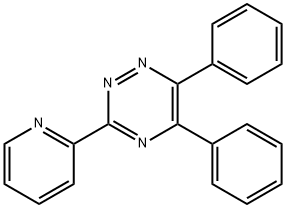
What is 3-(2-PYRIDYL)-5,6-DIPHENYL-1,2,4-TRIAZINE?
Chemical properties
yellow powder
The Uses of 3-(2-PYRIDYL)-5,6-DIPHENYL-1,2,4-TRIAZINE
3-(2-Pyridyl)-5,6-diphenyl-1,2,4-triazine was employed as chromogenic-extraction reagent during spectrophotometric determination of iron in acids and acidic solutions. It was also employed as precolumn derivatizing reagent in the HPLC method with UV absorbance detection for the Fe(II) determination.
Indications
PDT with 20% ALA may be used for the treatment of actinic keratoses. The product is marketed as Levulan Kerastick (DUSA Pharmaceuticals, Valhalla, New York). The ALA is applied diffusely over the field with an applicator; the patient returns 1 to 3 hours later and is exposed to an activating light source. Once exposed to the light, ALA produces singlet oxygen, which damages the cell membrane. Sixty-six percent of patients had total clearing of lesions at 8 weeks using blue light exposure for 15 minutes. Patients experience a burning pain but heal with an excellent cosmetic result. Photosensitivity lasts for 24 hours. An optional regimen is to apply ALA only to visible actinic keratoses; however, this method will not treat subclinical lesions. A variety of lasers and light sources can be used to activate the ALA, including blue light, yellow light, and broadband light; however, many details remain to be worked out, such as the optimal incubation times for the ALA when using each of the various light sources.
Definition
ChEBI: 5,6-diphenyl-3-(2-pyridyl)-1,2,4-triazine is a member of 1,2,4-triazines.
General Description
3-(2-Pyridyl)-5,6-diphenyl-1,2,4-triazine (PDT) reacts with Cu(II) perchlorate in ethanol to yield [Cu(PDT)2(ClO4)2].
Purification Methods
Purify it by repeated recrystallisation from EtOH/dimethylformamide. It is a reagent for estimating Fe(II) and Ru(II). [Chriswell & Schilt Anal Chem 46 992 1974, Kamra & Ayers Anal Chem 78 423 1975.]
Properties of 3-(2-PYRIDYL)-5,6-DIPHENYL-1,2,4-TRIAZINE
| Melting point: | 191-193 °C (lit.) |
| Boiling point: | 440.52°C (rough estimate) |
| Density | 1.2028 (rough estimate) |
| refractive index | 1.6400 (estimate) |
| storage temp. | Inert atmosphere,Room Temperature |
| form | powder to crystal |
| pka | -0.06±0.63(Predicted) |
| color | Light yellow to Yellow to Orange |
| Water Solubility | Soluble in water. |
| BRN | 542151 |
| Stability: | Stable. Incompatible with strong acids, strong oxidizing agents. |
| CAS DataBase Reference | 1046-56-6(CAS DataBase Reference) |
| EPA Substance Registry System | 1,2,4-Triazine, 5,6-diphenyl-3-(2-pyridinyl)- (1046-56-6) |
Safety information for 3-(2-PYRIDYL)-5,6-DIPHENYL-1,2,4-TRIAZINE
| Signal word | Warning |
| Pictogram(s) |
 Exclamation Mark Irritant GHS07 |
| GHS Hazard Statements |
H302:Acute toxicity,oral H315:Skin corrosion/irritation H319:Serious eye damage/eye irritation H335:Specific target organ toxicity, single exposure;Respiratory tract irritation |
| Precautionary Statement Codes |
P261:Avoid breathing dust/fume/gas/mist/vapours/spray. P264:Wash hands thoroughly after handling. P264:Wash skin thouroughly after handling. P270:Do not eat, drink or smoke when using this product. P301+P312:IF SWALLOWED: call a POISON CENTER or doctor/physician IF you feel unwell. P302+P352:IF ON SKIN: wash with plenty of soap and water. P305+P351+P338:IF IN EYES: Rinse cautiously with water for several minutes. Remove contact lenses, if present and easy to do. Continuerinsing. |
Computed Descriptors for 3-(2-PYRIDYL)-5,6-DIPHENYL-1,2,4-TRIAZINE
3-(2-PYRIDYL)-5,6-DIPHENYL-1,2,4-TRIAZINE manufacturer
ALPHA CHEMIKA
New Products
4,4-Difluoropiperidine hydrochloride tert-butyl 9-methoxy-3-azaspiro[5.5]undecane-3-carboxylate Indole Methyl Resin N-Isopropylurea N,N-Dicyclohexylcarbodiimide(DCC) MELDRUMS ACID 5-METHYLISOXAZOLE-4-CARBOXYLIC ACID Magnessium Bis glycinate Zinc ascorbate 1-bromo-2-butyne 2-acetamidophenol 9(10H)-anthracenone Erythrosin B, 4-Piperidinopiperidine 2-((4-morpholinophenylamino) (methylthio) methylene) malononitrile 2,4-dihydroxybenzaldehyde 3-(4-morpholinophenylamino)-5-amino-1H-pyrazole-4-carbonitrile Methyl 2-methylquinoline-6-carboxylate 2,6-dichloro-4-nitropyridine 4-Bromo-2-chlorobenzonitrile 2-(benzylamino)acetic acid hydrochloride 4-(tert-Butoxycarbonylamino)but- 2-ynoic acid 3,4-dihydro-2H-benzo[b][1,4]dioxepine 1-Phenyl-1-cycloprppanecarboxylicacidRelated products of tetrahydrofuran
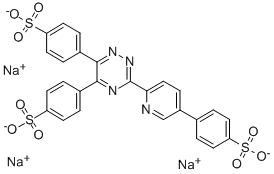



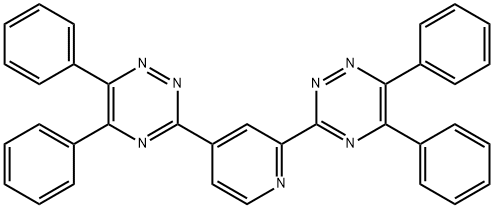
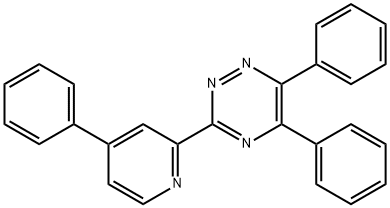
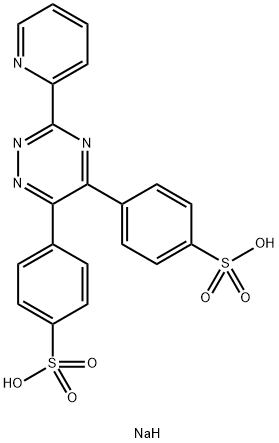
![2,4-BIS[5,6-DI(P-SULFOPHENYL)-1,2,4-TRIAZIN-3-YL]PYRIDINE TETRASODIUM SALT](https://img.chemicalbook.in/CAS/GIF/59895-79-3.gif)
You may like
-
 5,6-Diphenyl-3-(2-pyridyl)-1,2,4-triazine CAS 1046-56-6View Details
5,6-Diphenyl-3-(2-pyridyl)-1,2,4-triazine CAS 1046-56-6View Details
1046-56-6 -
 3(2-Pyridyl)-5,6-Diphenyl-1,2,4-Triazine (PDT) extrapure AR CAS 1046-56-6View Details
3(2-Pyridyl)-5,6-Diphenyl-1,2,4-Triazine (PDT) extrapure AR CAS 1046-56-6View Details
1046-56-6 -
 3-(2-Pyridyl)-5-6-diphenyl-1-2-4-triazine, 99% CAS 1046-56-6View Details
3-(2-Pyridyl)-5-6-diphenyl-1-2-4-triazine, 99% CAS 1046-56-6View Details
1046-56-6 -
 3-(2-PYRIDYL)-5,6-DIPHENYL1,2,4-TRIAZINE AR CAS 1046-56-6View Details
3-(2-PYRIDYL)-5,6-DIPHENYL1,2,4-TRIAZINE AR CAS 1046-56-6View Details
1046-56-6 -
 3-(2-Pyridyl)-5,6-diphenyl-1,2,4-triazine CAS 1046-56-6View Details
3-(2-Pyridyl)-5,6-diphenyl-1,2,4-triazine CAS 1046-56-6View Details
1046-56-6 -
 5gm 3- 2-PYRIDYL -5,6-DIPHENYL1,2,4-TRIAZINE AR 12375, Purity: 99%View Details
5gm 3- 2-PYRIDYL -5,6-DIPHENYL1,2,4-TRIAZINE AR 12375, Purity: 99%View Details
1046-56-6 -
 20677-73-0 (2,2-diethoxyethyl)methylamine 98%View Details
20677-73-0 (2,2-diethoxyethyl)methylamine 98%View Details
20677-73-0 -
 3-(4-(hydroxyamino)-1-oxoisoindolin-2-yl)piperidine-2,6-dione 98%View Details
3-(4-(hydroxyamino)-1-oxoisoindolin-2-yl)piperidine-2,6-dione 98%View Details
